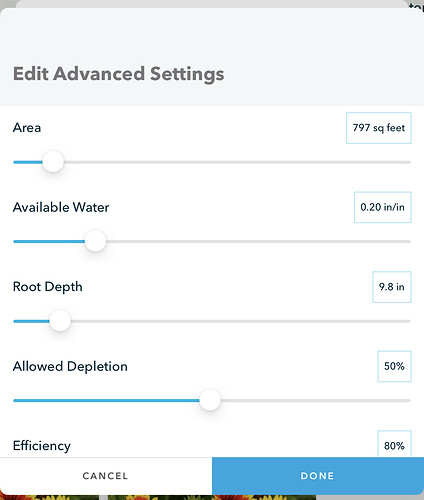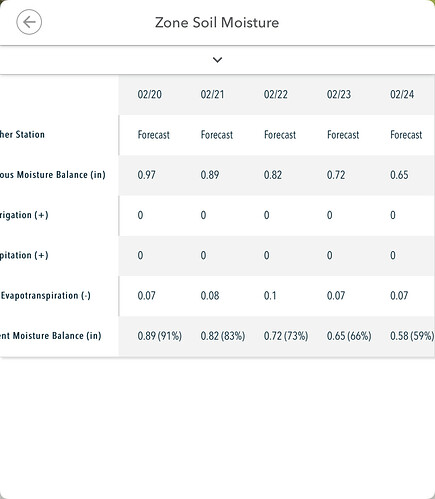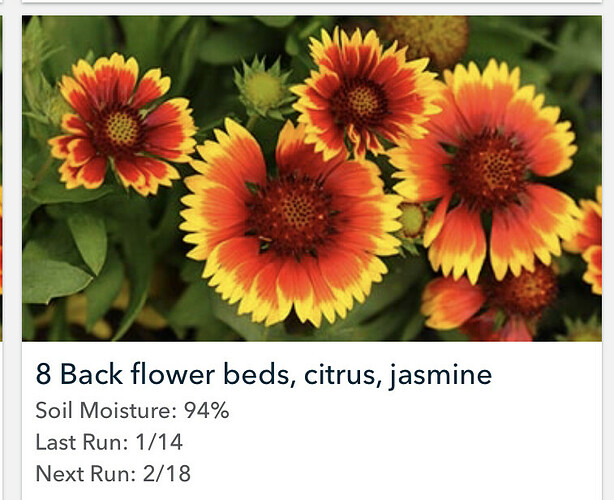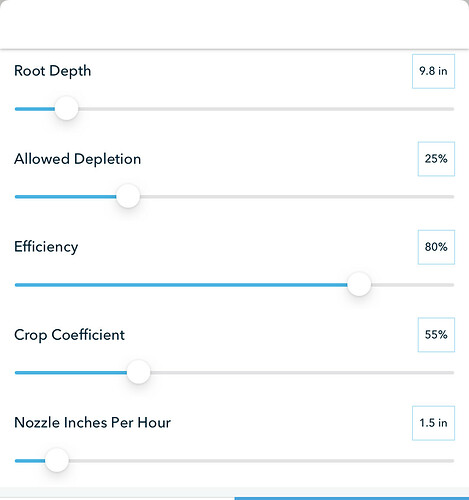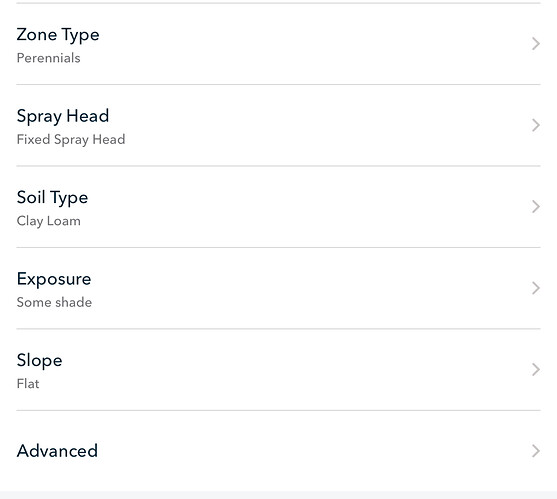I want to hear from your engineers as to why their algorithm does not work in Los Angeles. Constantly and demonstrably does not work. Why? Seems pretty basic to me. No rain = need to water. What is the disconnect?
Los Angeles is a desert. I have an 11 zone sprinkler system running on the Rachio. I have played with the zone settings to get it to behave more appropriately: changing plant types, soil types, etc. I have played with which local weather it will use for water programming. I have spent hours trying to get customer service to work with me. It is killing my plants. We had rain two weeks ago. Looking at the calendar function, the sprinklers are not scheduled to run for another two weeks. I checked the Rachio calendar going back to the last actual rain. The Rachio reported weather shown no rain, so it’s not using the wrong weather reports. I have no idea why this (faulty) algorithm would decide that plants in sun and temperatures ranging from 40 to 80 degrees do not need water for a month or more. I’m a geek. I wanted the algorithms to work. It’s not a complex programming task. I now have to water virtually manually, which is not the point. And I have to replace plants that did not survive this experiment
I can’t answer your question (I’m an engineer, but not a Rachio engineer), but assuming you’re using Flex Daily (as the topic says), the graph for each zone will tell you exactly why sprinkling will or will not occur. Have you checked it out? You may want to post a pic.
Hi…so nice of you to try. More than I’ve got from customer service. I assume this is what you mean by graph for each zone. This is an example of one that has received no water (rain nor sprinkler) in more than two weeks. The scheduler is not planning on water for another two more weeks. I’ve been messing with their variables for months and have accomplished nothing! My nod to defeat is finally setting up a weekly schedule.
Not allowing me to paste my screen shot…I have emailed it.
Thank you!!!
Found the upload. Thanks again
No, those are the advanced settings. When you click on a zone, instead of hitting Edit, click on the soil moisture percent. This will show you the moisture graph. As the line goes from top to bottom, the soil is drying out, and irrigation will occur when it reaches the bottom. Clicking on More Detail below the graph gives you digital values for each day.
Again, this is only for Flex Daily, but that’s where you posted this, so hopefully you’re using it.
I will attach those for a zone comprised of flowers and citrus trees. It is bone dry. And this is what I believe is the systems problem. As of feb 20, it will be almost a month since it has rained, yet the algorithm is lead to believe that the soil is still moist. Not here it isn’t. Maybe in other parts of the country it may be??
And while I think the company should be answering these questions, yet hasn’t the in months I’ve been asking, I greatly appreciate your time! Thank you
Okay, that helps a lot. I’d like to also see your Crop Coefficient on the Advanced screen, though.
As the graph shows, Rachio intends to water just under 1" of water at a time, then wait until that water is used, so you’re down to the 50% allowed depletion. And, your Crop Coefficient might be on the low side, as the graph is saying your zone only needs 0.07 to 0.1" of water per day. Using an average of 0.078" per day for the 5 days you showed, that means without rain and with weather staying the same, Rachio will water every 0.98/0.078 = 12.5 days. If it went longer than that, your weather was cooler, or you had some rain.
But - especially for flower beds, I feel that root depth is way high. Here in SC in the summer, Flex Daily waters about every 2-3 days in the heat, for the Centipede grass. But my wife’s butterfly garden (flowers) could never last that. They need a bit of water about every day. In fact, I run that zone, which includes grass, a couple minutes every afternoon during warm weather to help the flowers. I do see that Rachio uses 9.84" root depth for Perennials and 5.91" for Annuals, but I’d never set it that deep for them.
However, you also have citrus trees, which depending on size, can have MUCH deeper roots. Having flowers and trees, or even grass and trees, on a single zone is always a problem. In a couple places, I’ve added an external soaker hose around my trees in an otherwise flower & grass zone, giving them a slow long drink every week or so.
It is my experience that you have to design the operation of any zone to the crop requiring water most often, usually with the shallowest roots, which isn’t best for the other crops with deeper roots, but there’s no sense in having flowers if they die on you. Your 9.8" root depth is saying that you can water the area with 1" of water (calculated above), then not water it again until half of it has dried out. Flowers can’t last that way.
If I were you, I’d set the root depth for any area with flowers that you care about, or can’t do anything special with, to no more than 4-6". 5" would water that area half as much as it does now, but twice as often. AND - to start things out right, I would set EMPTY ANY zone you think is way dry now, using the EMPTY button on the zone’s graph. That will give a full watering the next available time, and then work from there. In zones where you have trees also, I’d do the Empty thing BEFORE resetting the root depth from 9.8" to 5", if you do that. You’ll be sure your roots are damp down deep, but then reset to 5" and water half as much, twice as often.
I’m still a little concerned with your Crop Coefficient. CC directly determines how much water over time your plants/lawn need. Doubling it will double the water applied over time (by halving the frequency, if nothing else is changed). Anyhow, check on the CC, and increase it 20% or so to increase water applied over time.
Also, are you confident of your Nozzle Inches per Hour? In my experience, that is ALWAYS a guess WAG on our part, and not something Rachio can really help with. If it’s off, you will under or over water, usually under. Measuring water flow over a period of time and measuring the zone’s square feet can go a long way to help adjust things.
Should have asked this first: How long have you been working with the Rachio? Was it working better for you previously? Are you having problems with other of your 11 zones?
Richard…I don’t know you, but I know enough to know that you are quite remarkable. That you are voluntarily providing customer support for a company that should be doing so itself, but refuses, is remarkable. Thank you.
It will take me a little bit to process and implement your suggestions, what I do not understand is why the variables presented and implied to be most important have almost nothing to do with the watering model the system builds. It is the variables that are almost “hidden” that are the ones that matter. I say hidden because after what amounts to a 20 email “dialog” and an more than an hour on the phone with a rep, you are the absolute first to suggest any of what you’ve suggested! Honestly, I have no idea what most of it means, but will, thanks to you, go through it and try to make the appropriate changes.
Most of my zones are mixed. It’s not optimal but it is the case. I have no lawn. Lawn is silly in Los Angeles. I have artificial turf, a few hill sides covered with ice plant, Cali natives and lantana. Another hillside covered with succulents and cacti. The rest is flowers, citrus, California honeysuckle, plumbago (a spreading bush) and podocarpus, a tall hedge like tree. I will readjust as you’ve suggested. I have had the Rachio since November. What I remain baffled about is how, given my programming of the obvious zone variables, while leaving the defaults at factory settings, why the Rachio would allow my gardens to go unwatered for more than a month when there has been no rain, I would like the Rachio engineers to answer that, because that is unacceptable. One should not have to be an engineer to use the system.
Richard…to address some of the specifics. All 11 zones are problematic in that we’ve had hardly any rain and Rachio has let them go a month or more without water. I am focusing on zone 8 and sending you photos. Yesterday, on your advice, I changed the moisture from 50 to 25%. The remainder at at their defaults.
I will be curious to see what @rraisley says. He is much better at explaining all this than I am. But I’m in NC, and I just checked my annual/perennial zone settings – I have my root depth at 7 inches and my crop coefficient at 85% (I also use allowed depletion at 25%) – During the hot season in NC, my system will water sometimes daily, and more often at every other day. I would also check your nozzle inches per hour – that’s a very critical setting.
Thank you. So sweet of you to answer! My problem was extremely extended periods of time with no rain and no water from the system. I have no idea what crop coefficient is, but have increased it, decreased allowed depletion and adjusted all root lengths as per https://community.rachio.com/u/rraisley.
I’m a doctor…taught statistics, built models, but didn’t realized I needed a degree in agricultural engineering to figure out the Rachio system. And as you may have noticed, I’ve had no help from customer service.
I’m not as comfortable with flowers & trees, as that’s problematic anyhow. Grass is much easier to get set IMHO, without the complexities of multiple crops in a single zone. But you’re concentrating on one zone (while I think you’d be more concerned about the other 10), so we’ll go with that.
As Linn said, I also think that a Crop Coefficient of 55% is low, even though Rachio lists it for perennials (80% for annuals). Changing the Allowed Depletion to 25% will cause the system to water less per cycle, but more often, and I think that’s fine (although not good for grass in summer - possibly in winter).
Also as Linn says, the Nozzle Inches per Hour is critical. And unfortunately, there is no easy way to check it. You can’t just look it up in a table, despite what people say. I only have 5 grass zones with the same type and size of sprinkler heads, and my actual Nozzle Inches per Hour vary between 0.33 and 1.06. And yes, having Nozzle Inches per Hour twice what it really is means your zone will get half as much water as it should be.
But again, for this zone and for the rest, if you know the ground is dry, and has been dry, and there’s no rain coming - EMPTY each zone, in order to immediately start watering all your zones! Your 94% soil moisture above tells me Rachio thinks the soil is saturated, and you know it’s not. It’s possible to underwater a zone for a long period of time and have it gradually go downhill, which it appears you now have. You can’t then just adjust a value or two and expect it to revive. Water that sucker when you know it needs it; don’t stand by and watch it die while you’re trying to figure out what’s wrong!
No, you don’t have to be an engineer to use the system (although it may help - I am one). Every irrigation guy I’ve talked to simply says “Water each zone for 20 minutes every other day”, not caring about over/under watering, because it will probably keep the zone alive. Trying to time when and how much water to apply to keep your lawn “just right” is a lot more work, but you’ll find a lot of people here willing to help.
Oh, and how did you contact Rachio for help? Your first post here was 2 days ago, and while I replied shortly after that, someone from Rachio would have too, I think, if I hadn’t.
That’s just a nice way of saying I talk a lot! But that’s okay; I do. ![]()
I followed your advice and emptied all the zones. You’re right, I am concerned with all 11, none of which are grass and all of which have the unknown water amount coefficient. So I’m tinkering with other variables like crop coefficient (whatever that means) and allowed depletion. I just heard from Dane who had some awesome suggestions. I did not know about the community and had been emailing and calling Rachio since November and getting less than helpful replies to the point of tearing my hair out! But, thanks to you guys, I’m getting there. I didn’t want to give up and just program a fixed schedule! Thank you!!!
Thank you both so much! It’s a good feeling to learn new “tricks”
Wow, 11 zones, none grass. You’ve got your work cut out for you! Hopefully you at least have several zones with the same plantings, so what works for one would work for the others.
Yeah, I know, you just want healthy plants, you don’t care about the science behind it. Can’t blame you I, OTOH, have spreadsheets for my irrigation, and look at them instead of TV for entertainment. ![]()
IMHO, to do things right with Flex Daily, you will probably need to measure each zone’s area and water flow per minute, to calculate proper Nozzle Inches per Hour. I can help you calculate area if you like, but to measure flow, you’d have to run each zone for X minutes (like 5), and read your water meter before and after. If you’re willing to do that, I think we can work through what you need for each zone. I’m happy to help.
As far as the terminology goes, Crop Coefficient is simply what percent of a standard water value per day/week is required for a crop. The National Weather Service calculates FRET (Forecast Reference crop EvapoTranspiration) for each location, which is how much water evaporates from an open pan each day. Temperature, humidity, wind, sunlight, etc. affect this, as you can imagine. The Crop Coefficient of 80% means a particular plant needs 80% of this value, rather than 100%. Allowed Depletion is how much of the water in the soil to the root depth is allowed to be depleted before the plant starts to wilt, and therefore needs watering. But again, we can help you with the terminology or settings.
If you don’t feel like doing the measuring (no pressure - I understand), then I think you might be better off with Flex Monthly. It uses historic rather than actual temperatures, and changes watering time and and frequency each month. Basically, you’d pick (guess) times for each zone, and then wait and see if you need more or less water, adjusting the time as required. All the same questions are there, but it’s done differently.
Thank you, again! I am trying to deal with the zone settings in groups, i.e., mostly perennials covers 4 zones. Rose bushes is two zones and I might need to figure out if they are more like bushes or perennials. What I understand now, that I didn’t prior to your help is how to change the two basic model outcomes…frequency and duration, by setting the values for crop coefficient (which I still don’t really get), root depth and moisture depletion. My water meter is down by the road, under some dense bushes and there is no way I’m putting my hand in there! So the water amount will have to stay as the default for sprinkler nozzles. But thank you so much for offering to help with that.
It’s interesting…I have a PhD in Applied Research…a branch of Psychology. One of the philosophies of the program was that you don’t really have to understand the details of particular field to research, analyze and model that fields variables. This exercise is testing that hypothesis for me!
Mostly correct. You’re right that Root Depth and Moisture Depletion (along with the soil’s Available Water) determines duration, with duration meaning the minutes of water applied per time (technically the inches of water applied at one time). And with duration/inches determined by those three then Frequency is determined by the Crop Coefficient. But I think a better way of looking at it is that Crop Coefficient determines the total water applied over a week/month/whatever (which as you say is done by frequency).
The main thing is that all those factors only calculate two things: How much water is applied at once, and how much water is used over days before the zone is “depleted” and you need to water again.
And Rachio basically wants to completely saturate your zone one day, then wait until the zone is dry enough (depleted) to require watering again.
Looking at your Rose Bushes zone (and you probably know much more than I do, just looking things up), they probably have roots on the order of 15" deep and have a crop coefficient of 0.5 to 1.0 (quite a range). Your soil means a lot (Available Water), as since you’ve probably amended the soil for the roses, or replaced it completely, make sure you set the type of soil you’re using for the roses, not what’s on your lot.

